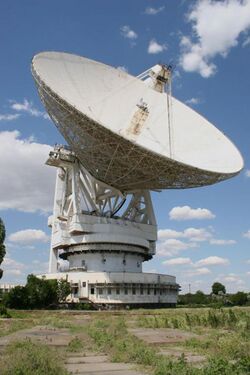Astronomy:RT-70
From HandWiki
This article needs additional citations for verification. (July 2013) (Learn how and when to remove this template message) |
There are three radio telescopes designated RT-70, all in countries that were once part of the former Soviet Union, all with similar specifications: 70m dishes and an operating range of 5–300 GHz. They are a part of the former Soviet Deep Space Network, now operated by Russia . The Yevpatoria facility has also been used as a radar telescope in observations of space debris and asteroids.
With their 70m antenna diameter, they are among the largest radio telescopes in the world.
They are:
- the Yevpatoria RT-70 radio telescope at the former soviet Center for Deep Space Communications or West Center for Deep Space Communications, Yevpatoria, Crimea.
- the Galenki RT-70 radio telescope at the East Center for Deep Space Communications, Galenki (Ussuriysk), Russia .
- the Suffa RT-70 radio telescope at the Suffa Radio Observatory on the Suffa plateau, Uzbekistan. Never completed.
In 2008, RT-70 was used to beam 501 messages at the exoplanet Gliese 581c, in hopes of making contact with extraterrestrial intelligence. The messages should arrive in 2029.[1]
See also
- RT-64, a smaller aperture Russian design.
References
- ↑ Moore, Matthew (9 October 2008). "Messages from Earth sent to distant planet by Bebo". .telegraph.co.uk. Archived from the original on 11 October 2008. https://web.archive.org/web/20081011142445/http://www.telegraph.co.uk/news/newstopics/howaboutthat/3166709/Messages-from-Earth-sent-to-distant-planet-by-Bebo.html. Retrieved 9 October 2008.
External links
- Yevpatoria RT-70 radio telescope (in Russian)
- Suffa RT-70 radio telescope (in Russian)
- Suffa Radio Observatory in Uzbekistan: progress and radio-seeing research plans
- Russian Space Agency Backs US Asteroid Control Plan (mentions Galenki telescope)
- Don P. Mitchel. Soviet Telemetry Systems. Deep-Space Communication Centers
| |
This article includes a list of related items that share the same name (or similar names). If an internal link incorrectly led you here, you may wish to change the link to point directly to the intended article. |
 |


